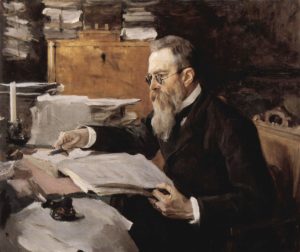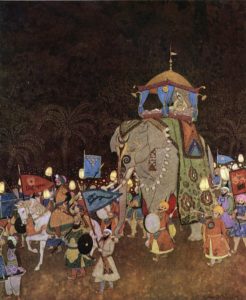This Thanksgiving, the Houston Symphony presents one of the repertoire’s most popular orchestral works: Rimsky-Korsakov’s Scheherazade. Discover the story behind this masterpiece inspired by The One Thousand and One Nights.
On February 27, 1887, the acclaimed Russian composer Alexander Borodin was attending a party when, after dancing a waltz, he dropped dead of a heart attack. The 53-year-old composer’s sudden passing sent shockwaves through Russia’s musical circles; Borodin had been one of their leading lights.

The loss was particularly hard for his friend and fellow composer Nikolai Rimsky-Korsakov. Almost immediately, Rimsky-Korsakov went to Borodin’s apartment to save his music. There he recovered his unfinished masterpiece, the opera Prince Igor. Wishing to rescue Borodin’s crowning achievement from oblivion, Rimsky-Korsakov resolved to complete it.
Thus, deep in the winter of 1888, Rimsky-Korsakov was hard at work on Prince Igor. Set long ago on the wild Russian steppe, Borodin’s epic opera was filled with striking, exotic music that must have fired Rimsky-Korsakov’s imagination. He soon conceived the idea of composing an orchestral suite full of his own exotic melodies. His subject: The One Thousand and One Nights.
A Classic Tale
The One Thousand and One Nights (or, more colloquially, The Arabian Nights) has a history as storied as the tales themselves. Indian, Persian and Arabic sources have been suggested for individual tales, and the first references to collections of “One Thousand Nights” are found in documents from the 10th century. The earliest surviving manuscript comes from 14th century Syria, which Antoine Galland freely adapted to create a French version, introducing the Nights to Europe for the first time in the early 18th century. It was likely a translation of Galland’s version that inspired Rimsky-Korsakov.
The individual stories of the Nights are famously unified by a frame story: the cruel Sultan Shahryar, convinced of the faithlessness of all women, takes a new bride every night only to have her executed at dawn, until one, Scheherazade, saves herself and wins his heart by telling stories, being sure to end each night in the middle of a tale. Rimsky-Korsakov would name his suite after her. He recalled composing it in his memoirs:

“The program I had been guided by in composing Scheherazade consisted of separate, unconnected episodes and pictures from The Arabian Nights, scattered through all four movements of my suite: the sea and Sinbad’s ship, the fantastic narrative of the Prince Kalandar, the Prince and the Princess, the Baghdad festival and the ship dashing against the rock with the bronze rider upon it…I meant these hints to direct but slightly the hearer’s fancy…All I had desired was that the hearer, if he liked my piece as symphonic music, should carry away the impression that it is beyond doubt an oriental narrative of some numerous and varied fairy-tale wonders and not merely four pieces played one after the other…”
The one tale that Rimsky-Korsakov definitely wrote into the score is the frame story, which is vividly depicted through music. The suite begins with a growling depiction of Shahryar, and Scheherazade soon replies, represented throughout the suite by a solo violin. She is often accompanied by a harp, evoking the centuries old traditions of bards accompanying themselves with this ancient instrument. She then conjures images of “the sea and Sinbad’s ship.” The waves are evoked by a gently rocking accompaniment in the cellos as the violins play a sinuous, chromatic melody in E major. As a synesthete who associated musical sounds with colors, Rimsky-Korsakov heard E major as the deep, dark blue of the sea. This depiction of the vast, beckoning ocean was also likely inspired by Rimsky-Korsakov’s time as an officer in the Russian navy, during which he sailed as far as Rio de Janeiro.
A Musical Masterpiece
Throughout, the music of Scheherazade showcases Rimsky-Korsakov’s mastery as an orchestrator; in terms of the pure, sensory pleasure of sound, he is unsurpassed. The music of the waves alternates with delicate passages for solo instruments, and each time the “waves” return, the orchestration becomes richer and grander, climaxing in a shimmering fortissimo.
Scheherazade’s violin solo also introduces the next movement: “the fantastic narrative of the Prince Kalandar.” In the medieval Islamic world, a Kalandar was a wandering mystic who led an ascetic lifestyle, relying on charity for his sustenance. Thus, the idea of a Kalandar-Prince might seem paradoxical. In the Nights, there are in fact three Kalandar Princes, each of whom began life as a prince, but, through a series of fantastical misfortunes, was blinded in one eye and reduced to the beggary of a Kalandar. We cannot be sure which of the three Kalandar Prince’s stories Rimsky-Korsakov had in mind when composing this movement, but the music has a sense of adventure that fits them all.
Though some candidates have been proposed, it is difficult to identify a particular story to go with the third movement, “The Prince and Princess.” Love is a common theme throughout the Nights, and this movement shows Rimsky-Korsakov at his most lyrical. Not everyone appreciated this tenderness, however; an early London performance of Scheherazade provoked the rather prudish English press to debate whether this figure in the clarinet depicted kisses:

This makes it is easy to understand why Rimsky-Korsakov was hesitant to provide too much detail about his sources of his inspiration.
In this movement, Scheherazade’s theme returns not at the beginning, but in the middle, as if she has paused for a moment to comment on the story. Her violin solo then blends with the music of the prince and princess. The passionate climax that follows surely represents not only the young lovers, but Scheherazade and Shahryar as well.

The finale bears the title of “Festival at Baghdad. The Sea. Ship Breaks upon a Cliff Surmounted by a Bronze Horseman.” After an introduction from Scheherazade’s violin solo, the festival gets underway. Again, it is difficult to identify a specific story to match the festival, but this passage describing the wedding of Scheherazade and Shahryar seems to fit:
“…they decorated the city after the goodliest fashion and diffused scents from censers and burnt aloes-wood and other perfumes in all the markets and thoroughfares…what while the drums beat and the flutes and pipes sounded and mimes and mountebanks played and plied their arts…”
Melodies from the second and third movements return during the course of the festival (compare to the original versions here and here), although Rimsky-Korsakov said his motivations for these reappearances were purely musical and cautioned listeners not to read too much into them from a narrative point of view. As this wild spectacle reaches its climax, the sea music from the first movement returns with the logic of a dream, and we witness the catastrophe of the shipwreck (a reference to the third Kalandar Prince’s tale). The waves subside, and Scheherazade’s violin solo rises high above the low, slumbering melody of Shahryar. As the solo violin soars to its highest register, the music fades into nothing, bringing Scheherazade’s magical tales to an end. –Calvin Dotsey
Don’t miss Rimsky-Korsakov’s Scheherazade this Thanksgiving weekend, November 24, 25 & 26, 2017! For tickets and more information, visit houstonsymphony.org.




Thank you for this glorious description of Scheherazade. I can’t wait to hear the Houston Symphony’s rendition! This is one of my favorite classical pieces, yet I’ve never had the opportunity to hear it live. What better orchestra than the Houston Symphony to play Scheherazade! I’m beside myself with excitement!
Suzy Barbee